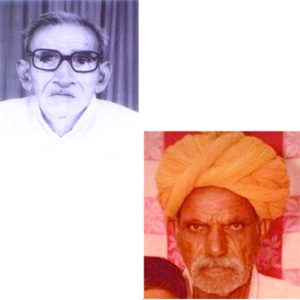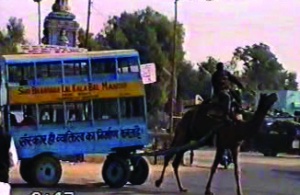Name : Late Shri Mewaram Jangid and Late Shri Radhey Shyam Mishra
District & State : Churu, Rajasthan
Category : Transport
Award : Appreciation
Award Function : 4th National Grassroots Innovation Awards
Award Year : 2007
Innovation Description
Transportation in rural areas has always been a great problem and the problem increases manifold in the desert environments. Late Shri Mewaram Jangid and Late Shri Radhey Shyam Mishra realized this problem and came up with a camel bus to facilitate cheap, safe and comfortable transport for school going children
Late Shri Mewaram Jangid
 Born and brought up in Sujangarh, Shri Jangid never went to school. He repaired wood and metal furniture. He is survived by two sons, who have carried forward his work. Being sensitive and caring by nature, Shri Jangid was always looking for ways to help people and make their life easier. His sons, friends and neighbours also helped him in his noble endeavours. Given the task by school authorities, Shri Mewaram came up with a mule-driven two-tyre cart in 1959 and subsequently converted it to camel driven two-tyre double decker cart. Staff and management of Bhawarlal Kalabal Mandir School, especially Shri Motaram who was instrumental in trying out buses and getting raw material, helped him a lot.
Born and brought up in Sujangarh, Shri Jangid never went to school. He repaired wood and metal furniture. He is survived by two sons, who have carried forward his work. Being sensitive and caring by nature, Shri Jangid was always looking for ways to help people and make their life easier. His sons, friends and neighbours also helped him in his noble endeavours. Given the task by school authorities, Shri Mewaram came up with a mule-driven two-tyre cart in 1959 and subsequently converted it to camel driven two-tyre double decker cart. Staff and management of Bhawarlal Kalabal Mandir School, especially Shri Motaram who was instrumental in trying out buses and getting raw material, helped him a lot.
Late Shri Radhey Shyam Mishra “Bhaiyya Ji”
Radhey Shyam Mishra was popularly known as ?Bhaiya ji? because of his pleasing personality. He had great love and affection for children and started teaching at the age of seventeen years. Gradually, as the number of his pupils increased, he opened a school ?Bal Mandir? in an old building, then known as ?Bagla Dharamshala? and which now offices ?The Young?s Club of Sujangarh?.In 1956, rewarding his love and dedication for children, a rich man of Sujangarh, Shri Bhanwar Lall Kala established a Montessory School named after himself and gave complete management charge of the school to Mishraji.Bhaiya ji passed his Matriculation in 1961 from Hyderabad and got training in Montessory system of teaching. Being a visionary, he adopted latest teaching methods and soon his efforts brought a new dimension to the primary education in the area. He introduced children poems, dramas, children-fairs and many other co-curricular activities and always motivated them and the staff members to participate.
Genesis
BL Kala Bal Mandir, the school with a modest beginning in 1956, slowly expanded in size and quality with sincere efforts and devotion of all. Increase in the number of pupils brought the problem of safe transportation to the surface. Mishraji was concerned for the students along with their parents and was continuously thinking of suitable means to bring children safely from their houses to school and back to their houses. He even went around several parts of the country, including Delhi and Haryana, to look for a suitable answer to this problem. The school was initially using horse driven bogies and a camel driven vehicle for ferrying four-five schoolchildren. Given the terrain, buses were not suitable for carrying students. The horse driven tongas were of small capacity and expensive and were not safe and comfortable. The thought of a camel driven bus came to his mind and he approached Mewaram and other carpenters of the area. He explained them the idea of a possible larger and double decker camel bus for the school. Mewaram accepted the challenge to develop such a vehicle for children. He developed a prototype of such a bus and successfully displayed its working. As a result, the first four-wheeler camel driven bus rolled out in 1972.One of the main problems Mewaram faced was of getting tyres for the bus, as they needed to be broad to minimize the pressure on desert sand. Therefore, discarded tyres of aircrafts were sourced from Jaipur and Delhi, as they were broad and hence reduced the pressure on sand due to increased surface area.On teacher?s day, 5th September 1971, Bhaiyyaji was honoured with the State Award by the Government of Rajasthan for his work and contribution. The cost of construction comes around sixty to seventy thousand rupees. The camel bus can transport eighty children. It is a simple affordable local solution for mass transportation of schoolchildren. Seven such buses are in use to transport over 400 students daily in Bhanwarlal Kala Bal Mandir School. According to the school principal, ?the school has developed a distinct identity because of the Camel bus and other schools in the area have also followed suit?. Buses currently used by the school were made by another workshop owner, Chand Mal Todi, though it is still based on the design of late Shri Mewaram.
http://nif.org.in/innovation/Camel_Driven_double_decker_Bus/369
